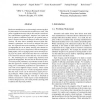Free Online Productivity Tools
i2Speak
i2Symbol
i2OCR
iTex2Img
iWeb2Print
iWeb2Shot
i2Type
iPdf2Split
iPdf2Merge
i2Bopomofo
i2Arabic
i2Style
i2Image
i2PDF
iLatex2Rtf
Sci2ools
SP
2007
IEEE
2007
IEEE
Trojan Detection using IC Fingerprinting
Hardware manufacturers are increasingly outsourcing their IC fabrication work overseas due to much lower costs. This poses a significant security risk for ICs used for critical military and business applications. Attackers can exploit this loss of control to substitute Trojan ICs for genuine ones or insert a Trojan circuit into the design or mask used for fabrication. We show that a technique borrowed from sidechannel cryptanalysis can be used to mitigate this problem. Our approach uses noise modeling, to construct a set of fingerprints for an IC family utilizing side-channel information such as power, temperature, and electromagnetic (EM) profiles. The set of fingerprints can be developed using a few ICs from a batch and only these ICs would have to be invasively tested to ensure that they were all authentic. The remaining ICs are verified using statistical tests against the fingerprints. We describe the theoretical framework and present preliminary experimental results to show...
| Added | 04 Jun 2010 |
| Updated | 04 Jun 2010 |
| Type | Conference |
| Year | 2007 |
| Where | SP |
| Authors | Dakshi Agrawal, Selçuk Baktir, Deniz Karakoyunlu, Pankaj Rohatgi, Berk Sunar |
Comments (0)

